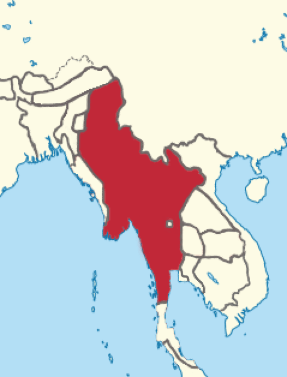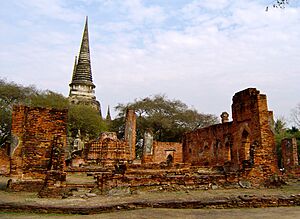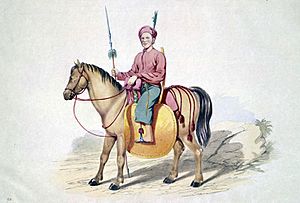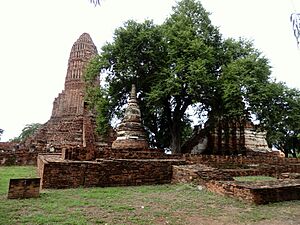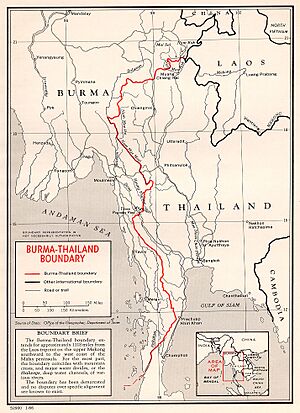Hsinbyushin facts for kids
Quick facts for kids Hsinbyushinဆင်ဖြူရှင် |
|||||
|---|---|---|---|---|---|
| King of Burma Prince of Myedu |
|||||
| Reign | 28 November 1763 – 10 June 1776 | ||||
| Coronation | 16 May 1764 | ||||
| Predecessor | Naungdawgyi | ||||
| Successor | Singu | ||||
| Born | Maung Ywa (မောင်ရွ) 12 September 1736 Moksobo |
||||
| Died | 10 June 1776 (aged 39) Ava (Inwa) |
||||
| Burial | Ava | ||||
| Consort | Me Hla 15 queens in total |
||||
| Issue | 20 sons, 20 daughters including: Singu | ||||
|
|||||
| House | Konbaung | ||||
| Father | Alaungpaya | ||||
| Mother | Yun San | ||||
| Religion | Theravada Buddhism | ||||
Hsinbyushin (Burmese: ဆင်ဖြူရှင်, meaning "Lord of the white elephant") was a powerful king of Burma (now Myanmar). He ruled from 1763 to 1776. Born on 12 September 1736, he was the second son of Alaungpaya, who started the Konbaung dynasty. Hsinbyushin is famous for his many wars. He fought against China and Siam (now Thailand).
He successfully defended Burma from four invasions by China. This helped keep Burma independent. His invasion of Ayutthaya in 1765 ended the Ayutthaya Kingdom. Winning against both China and Siam at almost the same time showed his great military skill. In April 1775, he also made the Shwedagon Pagoda taller.
As king, Hsinbyushin wanted to expand his empire. By 1767, his armies had stopped a rebellion in Manipur. They also took control of the Laotian states. His forces destroyed Ayutthaya and pushed back two Chinese invasions. However, fighting two major wars at once was very risky. The third Chinese invasion forced him to leave Siam quickly. A shaky peace with China was made in 1769.
His constant wars meant the country was always ready for battle. This led to army commanders treating people badly. In 1773, a rebellion by Mon soldiers was put down very harshly. In 1774, Hsinbyushin became very ill. This made local governors and army leaders act even more independently. In 1775, areas like Lan Na and Manipur rebelled. He died in June 1776 while his armies were still fighting. After his death, Burmese forces left Siam. His wars helped Burma gain control of parts of the Taninthayi Region, Shan State, and Kachin State.
Contents
Early Life of Hsinbyushin
The future king was born Maung Ywa on 12 September 1736. His parents were Aung Zeya and Yun San. They lived in Moksobo, a village about 60 miles northwest of Ava. His father, Aung Zeya, was the village chief. His family had managed the Mu river valley for many years.
Maung Ywa grew up when the old Toungoo dynasty was losing power. From the 1720s, Manipuris often raided Upper Burma. Ywa's home area was hit hard by these raids. The Burmese court could not stop them. Villages were burned, and people were taken captive. In 1740, the Mon people in Lower Burma broke away. They started their own kingdom. The central government became very weak. On 23 March 1752, the Mon armies captured Ava. This ended the Toungoo dynasty.
Becoming a Military Leader (1752–1760)
Three weeks before Ava fell, Maung Ywa's father, Aung Zeya, started the Konbaung dynasty. He called himself King Alaungpaya. He wanted to fight against the Mon rule. Many young men joined him, wanting to fix the problems of the past. The 15-year-old Ywa eagerly joined his father. He would later become the most warlike of all Konbaung kings.
Ywa, now called Thado Minsaw, quickly showed he was a skilled military leader. He became one of Alaungpaya's top commanders. By December 1753, Konbaung forces had pushed back the Mon invaders from Ava. The 17-year-old prince was put in charge of taking Ava back. On 3 January 1754, his attack worked. The Mon troops had to leave. Alaungpaya was pleased. He made his second son the governor of Ava.
Just three months later, the Mon forces returned with a huge army. Hsinbyushin and his older brother Naungdawgyi were badly defeated. Hsinbyushin went back to Ava and had to defend it during a siege. His defenses held strong. Other Mon armies also attacked the Konbaung homeland but were pushed back. In April 1754, Hsinbyushin broke the siege of Ava. He chased the retreating Mon armies. Alaungpaya gave Hsinbyushin the town of Myedu as a reward. From then on, he was known as the Prince of Myedu.
Throughout the 1750s, Hsinbyushin was a key commander. He helped Alaungpaya reunite all of Burma by 1759. They also drove out the French and British who had helped the Mon. Hsinbyushin was second-in-command during Alaungpaya's invasion of Siam (1759–1760). The Burmese forces reached the capital, Ayutthaya, in April 1760. But they had to retreat quickly because Alaungpaya suddenly became ill. Hsinbyushin was by his father's side when the king died.
Becoming King (1760–1763)
After Alaungpaya died, his oldest son, Naungdawgyi, became king. Alaungpaya had said that all his six sons from his first wife would become king in order of age. Hsinbyushin had promised his father to follow this wish. But right after his father's death, Hsinbyushin tried to take the throne. He asked the top military leaders for their support. However, he did not get enough help. Naungdawgyi forgave his brother. He needed to deal with other rebellions at the time.
Hsinbyushin was now officially the next in line to the throne. He watched his brother put down the rebellions but did not help. Naungdawgyi managed to stop the revolts by January 1762. He even took back Lan Na in January 1763. By then, Naungdawgyi's power was very strong. Hsinbyushin was ready to wait his turn. But in November 1763, Naungdawgyi, only 29, suddenly died. The ambitious Hsinbyushin, then 27 years old, became king.
Hsinbyushin's Reign
On 28 November 1763, Hsinbyushin became king. His full royal name was Thiri Thuriya Dhamma Razadhipati Hsinbyushin. Later, on 3 January 1768, he took a new reign name: Thiri Thuriya Dhamma Mahadhammaraza Razadhipati.
Rebuilding the Capital
One of his first tasks was to rebuild Ava. He wanted to make it his capital again. On 27 November 1764, he ordered the capital to move from Sagaing to Ava. The gates of the rebuilt Ava were named after the places he had conquered. He officially moved to Ava in April 1765.
Cultural Achievements
In 1765, Hsinbyushin ordered the translation of important Sanskrit books. These books were about grammar, medicine, and astrology. A monk named Maungdaung Sayadaw translated them. He had help from nine scholars from Varanasi, India. In 1771, a new law book was created. It was called Manusara Shwe Min Dhammathat. It was based on older law books and written in Burmese and Pali. In 1774, he made the Shwedagon Pagoda taller. He covered it with gold and added a golden spire with gems.
Even though he was known for wars, Hsinbyushin loved poetry. One of his queens, Ma Htwe, was a famous poet. A secretary named Letwe Thondara was sent away by Hsinbyushin. But he wrote a famous poem about his sadness. This poem helped him return to the court two months later.
Military Campaigns and Victories
Manipur (1764–1765)
Hsinbyushin wanted to fight Siam again. He started getting ready as soon as he became king. By November 1764, he had two armies ready for invasion. While he was preparing, Manipur, which had been under Burmese control since 1758, rebelled. Hsinbyushin did not call back his armies. In December 1764, the king himself led an army to Manipur. The Burmese army easily defeated the Manipuris and captured Imphal. The ruler of Manipur ran away. Hsinbyushin brought hundreds of Manipuris back to Burma. The king and his armies returned to the newly rebuilt Ava in April 1765.
Laotian States (1765)
Before attacking Siam, Hsinbyushin wanted to secure the areas north and east of Siam. In January 1765, a large Burmese army invaded the Laotian states. The Kingdom of Vientiane agreed to become a Burmese vassal without a fight. Luang Prabang resisted. But the Burmese forces easily captured the city in March 1765. This gave Burma full control of Siam's northern border.
Siam (1765–1767)
The Ayutthaya Kingdom was one of the richest cities in Southeast Asia. Burma and Siam had often fought over the Tenasserim region. For 150 years, Burma controlled the northern ports, while Siam controlled the southern ones. Since the Mon rebellion in the 1740s, Ayutthaya had supported the Mon rebels against Burma. After some smaller attacks, Burmese leaders noticed that Siam's army was slow to respond. The invasion of Ayutthaya was planned to gain the riches of this wealthy city.
After conquering the Laotian states in 1765, the northern Burmese army moved to Lan Na. In the south, another army gathered near Tavoy (Dawei). In August 1765, the northern army invaded Siam. In October 1765, the southern army joined in. The Burmese armies captured and destroyed most of Ayutthaya's major cities. Many Siamese people fled into the jungles. Some Siamese soldiers even joined the Burmese armies.
The Burmese forces reached Ayutthaya on 20 January 1766. They began a difficult 14-month siege. The people of Ayutthaya fought bravely. In January 1767, a huge fire destroyed 10,000 houses in the city. The Burmese armies finally broke through the city's defenses on 7 April 1767. They then looted and burned the entire city. Gold, cannons, books, people, royals, musicians, and artists were all taken back to Ava.
Most of the Burmese armies returned with their treasures. A few small groups were left in Siamese outposts. By late 1767, Hsinbyushin had to call back even more soldiers from Siam. He needed them to fight the Chinese invasions.
One lasting effect of the Ayutthaya attack was the creation of the Yodia people. These were descendants of the Siamese people moved to Burma. Siamese musicians and artists played important roles in the Ava court. They greatly influenced Burmese arts and culture.
Chinese Invasions (1765–1769)
The conflict with China started in 1758. Burma wanted to regain control of border areas. These areas had historically paid tribute to both Burma and China. But since the 1730s, they had only paid tribute to China. At first, China used local militias. But by 1765, the Qianlong Emperor sent in regular Chinese troops. The Chinese began their invasion in December 1765. This was just as Burmese armies were marching towards Ayutthaya. Hsinbyushin refused to call back his main armies from Siam. At first, this plan seemed to work. The remaining Burmese armies easily defeated the first two Chinese invasions at the border.
But in November 1767, the Burmese were surprised. A 50,000-strong Chinese force invaded again. This army included elite Manchu soldiers. The main Chinese army defeated the Burmese in December 1767. This made Hsinbyushin finally call back his remaining soldiers from Siam. The Chinese army advanced and reached Singu, 30 miles north of Ava, by late January 1768. Hsinbyushin stayed calm. He personally organized the defenses. With soldiers returning from Siam, the Burmese forces defeated the main Chinese army in March 1768.
After the third invasion, both sides tried to make peace. But the Qianlong Emperor made it clear he would not compromise. Ava now expected another big invasion. A Thai-Chinese nobleman, Phraya Tak, was reuniting Siam. Also, Manipur rebelled again in mid-1768. But Burma could do little. The survival of their kingdom was at stake.
When the next Chinese invasion came in October 1769, the Burmese were ready. They stopped the 60,000-strong invasion force at the border. By early December, all Chinese forces were surrounded. The Chinese commanders asked for peace. The Burmese commanders, led by Gen. Maha Thiha Thura, were worried. They thought another defeat would make China even more determined. Without Hsinbyushin's knowledge, they agreed to a truce. They allowed the Chinese to leave without their weapons. This shaky truce was not recognized by either side. Qianlong did not accept the agreement. Hsinbyushin was very angry that his generals had acted without his permission. He tore up his copy of the treaty.
Manipur (1770)
Knowing the king was angry, the Burmese armies were afraid to return to the capital. In January 1770, they marched to Manipur. A rebellion had started there, taking advantage of Burma's troubles with China. After three days of fighting, the Manipuris were defeated. Their ruler fled. The Burmese put their own chosen ruler on the throne and returned. The king's anger had lessened. After all, his armies had won and saved his throne. He sent Maha Thiha Thura and other generals away for a month.
Later Years and Illness (1770–1774)
After their last invasion, the Chinese kept many soldiers near the border for about ten years. They hoped to start another war. They also banned trade between the two countries for two decades. So, Burma was busy with its northern border for several years. Hsinbyushin did not restart the war with Siam, which was now stronger under new leaders.
Mon Rebellion (1773)
By 1773, Hsinbyushin felt he had waited long enough. He thought about renewing the war with Siam. He sent an army to Chiang Mai. He also asked the governor of Martaban to raise an army. However, he had to stop the invasion. The southern army in Martaban, mostly made of Mon troops, rebelled.
The rebellion happened because Burmese army commanders were acting like warlords. They were very proud after their victories. They treated the local people and even Mon officers badly. The conflict started when the governor of Martaban had a disagreement with a Mon officer. The governor sent the Mon troops to the front. Then he demanded money from the families of Mon officers. When the Mon soldiers heard this, they returned and rebelled. They pushed the Burmese troops back to Yangon.
The army eventually put down the rebellion very harshly. About 3000 officers and their families escaped to Siam. The rest of the people could not leave. They suffered greatly from the army's actions.
King's Health Declines (1774)
Hsinbyushin's control over his commanders got worse in 1774. The king became very ill. This illness lasted a long time and eventually caused his death two years later. His brother Naungdawgyi and possibly his father Alaungpaya may have died from the same illness. The palace was full of rumors about who would be the next king. Army commanders, who were already acting like warlords, ignored the king's orders. The king, once confident, became very suspicious. He only trusted his French commander, Pierre de Milard. Sometimes he asked de Milard to sleep in his room to protect him.
In December 1774, he ordered the execution of the last Mon king, Binnya Dala. This king had been held captive since 1757. Hsinbyushin ordered this because the Mon rebels had tried to free the former king. This was despite the fact that Hsinbyushin's father had pardoned the former king's life.
In April 1775, he made the Shwedagon Pagoda taller. He covered it with gold equal to his own weight. He also put a golden spire with gems on top.
Lan Na Rebellion (1774–1775)
The bad behavior of the Burmese government also caused a rebellion in Lan Na. The new Burmese governor in Chiang Mai was disrespectful to local chiefs and the people. He became very unpopular. His harsh rule even disgusted Gen. Ne Myo Thihapate, who was stationed there in 1773. The general even protected one of the chiefs who was being hunted by the governor. After Thihapate's army left, this chief and others fled to Siam. They started a rebellion. They attacked Chiang Mai with Siamese forces. They captured the city on 15 January 1775. This ended 200 years of Burmese rule in Chiang Mai.
Renewed Wars (1775–1776)
Siam (1775–1776)
After Chiang Mai fell, Hsinbyushin had to act. The king, though very ill, ordered a new invasion of Siam. He put Maha Thiha Thura in charge. He still trusted this general because his oldest son, Singu, was married to the general's daughter. But the general found it hard to raise an army. There was also a lot of disobedience among the Burmese commanders. To make things worse, Manipur also rebelled in 1775. The former ruler of Manipur, who had been driven out in 1770, returned. He overthrew the Burmese ruler. Hsinbyushin sent part of his army to Manipur instead of focusing on Siam.
The Siamese invasion was delayed until after the rainy season of 1775. A total of 35,000 soldiers were gathered for the Siamese war. In November, Maha Thiha Thura's main army invaded from the south. Another army invaded from the north. From the start, the invasion had problems. The army of 35,000 was too small. The 1765 invasion had at least 50,000 troops. More importantly, the Burmese command was in chaos. With the king dying, disobedience was common. The second-in-command of the southern army disagreed with Maha Thiha Thura. He left with his troops.
The remaining Burmese armies fought their way into Siam. They faced strong Siamese resistance. The northern army captured Chiang Mai. The southern army fought its way to Phitsanulok and Sukhothai in central Siam. They destroyed these cities, just like Ayutthaya in 1767. But the army could not go further south because they ran out of food.
Then, Hsinbyushin died on 10 June 1776, at age 39. Maha Thiha Thura decided to stop the invasion. He rushed back to Ava to make sure his son-in-law, Singu, could become king. The northern army also pulled back. If Hsinbyushin had lived longer, the army might have reached the new Siamese capital.
Manipur, Cachar, Jaintia (1775–1776)
In Manipur, the Burmese army again drove out the Manipuri ruler. He fled to neighboring Cachar and Jaintia. This time, Hsinbyushin ordered the army to chase him into these small kingdoms. Hsinbyushin died soon after. Even after the king's death, the Burmese continued to operate in Cachar and Jaintia. The ruler of Cachar finally gave up. But the Burmese still could not catch the Manipuri ruler. Burma gained some control over Cachar and Jaintia. But the Burmese army suffered many losses.
After Hsinbyushin's Reign
Hsinbyushin was only 39 when he died. He left behind 20 queens and 41 children.
Hsinbyushin had chosen his oldest son, Singu, to be the next king. This went against his father Alaungpaya's wish. Alaungpaya had said that all his sons should become king in order of age. Four of Hsinbyushin's brothers were still alive. But with Maha Thiha Thura's support, Singu became king without problems. The new king quickly removed anyone who might challenge his rule.
Hsinbyushin's constant wars had a high cost for the kingdom. His risky decision to fight Siam and China at the same time almost cost Burma its independence. Chinese armies came within 30 miles of Ava. He learned from this mistake. China kept a strong military presence on the border for about ten years.
His armies won many battles, but these victories did not last long. Burma had little control over the new lands it gained. His repeated wars in Manipur, Cachar, and Jaintia brought only temporary wins. Control over Cachar and Jaintia was weak. Manipuri rebellions continued after Hsinbyushin's death. Manipur became independent in 1782. Also, the Burmese army went deep into Siam again in 1775–1776. But they could not defeat the new Siamese government. Hsinbyushin's destruction of Ayutthaya led to a stronger Siam. This new Siam became a tougher rival to Burma. Their rivalry continued for another 70 years.
Another lasting problem was the rise of warlord behavior by army commanders. This got worse after Hsinbyushin became ill. The harsh rule of army commanders and governors pushed people to their limits. The Mon rebellion in the south was crushed. But the rebellion in Chiang Mai succeeded. His constant wars left the kingdom tired. People were relieved when his son Singu did not continue aggressive warfare.
Hsinbyushin's Legacy
Hsinbyushin is one of the most famous kings in Burmese history. He is known for his victories over China and Siam. Historians say his wins showed amazing strength, like that of Bayinnaung. His father's military traditions were not just kept, they were surpassed. Hsinbyushin's wars led to a new military class in Burma. They also brought cultural and economic wealth from Ayutthaya. But they also led to a stronger Siam. His wars changed the borders between Burma, China, and Thailand. They also affected modern Burmese-Thai relations.
Burmese Military Power
Hsinbyushin's campaigns helped repopulate Burma after earlier problems. His and his father's constant wars created a military aristocracy. This made Burma a great military kingdom. They defended Burma against the Chinese Empire and sacked Ayutthaya.
The Konbaung dynasty continued its military actions. They marched armies through the snowy Himalaya mountains. They conquered the Brahmaputra Valley. They even launched a nearly successful attack into British Bengal. This caused panic in Calcutta, the capital of British Bengal. Even though Burma lost that war, it was the British East India Company's most expensive war. It led to the company closing down. The Konbaung rulers' military campaigns also brought new military units into the army. This included Manipuri cavalry in the 1820s.
Destruction of Ayutthaya
Hsinbyushin's most lasting achievement was the destruction of Ayutthaya. This city was one of the most diverse cities in Southeast Asia at the time. Hsinbyushin's invasion moved all the wealth from Ayutthaya to Ava. This allowed Hsinbyushin to fund projects. For example, he made the Shwedagon Pagoda taller in 1775. The 50 years of constant war between Burma and Siam (1759-1812) left large areas of Siam empty. Some Siamese provinces remained deserted until the 1870s. The descendants of Ayutthaya captives taken to Burma in 1767 are sometimes called the Yodaya people. Also, taking Ayutthayan artists to Burma spread Siamese arts and culture. This greatly influenced Burmese culture. The Ayutthaya elite who were taken to Burma settled in well.
Stronger Siam
However, Hsinbyushin's decision to destroy Ayutthaya was a long-term mistake. While he gained wealth and people, destroying Ayutthaya made many Siamese leaders stronger. They decided to build a powerful military. This expanded Siam's influence to its greatest extent. The new Siam became a tough competitor to Burma. It eventually took Lan Na, Vientiane, and Luang Prabang from Burmese control. The main goal of conquering Ayutthaya was to stop Siam from helping Mon rebels. But the new Siamese leaders continued to help Mon rebels. They sent armies to the Tenasserim region for decades. They also brought many Mon refugees to their new capital in Bangkok. Burma also lost its long-time vassal, Lan Na, to Siam. Other areas that had recently paid tribute to Burma, like Vientiane and Luang Prabang, also came under Siamese control a few years after Hsinbyushin's death.
Today's Borders
Burma's success in the Sino-Burmese War helped create the current border between China and Burma. A large area from today's Kachin State to northern and eastern Shan State is still part of Myanmar. Burma gained Tenasserim from the 1765 war. Siam could not get it back in later conflicts. Tenasserim had been divided between Siam and Burma for about 150 years before Hsinbyushin's wars. All of Tenasserim remained under Burmese control until 1826. Then, Britain took it after the First Anglo-Burmese War. It was given back to independent Burma 120 years later.
Lasting Rivalry
The strong dislike felt by Thais towards the Burmese largely began during Hsinbyushin's reign. This was because of the complete destruction of the Siamese capital, Ayutthaya, in 1767. A Siamese writer said: "The king of Hanthawaddy (Bayinnaung) waged war like a monarch but the king of Ava (Hsinbyushin) like a robber." The Burmese invasion of Ayutthaya in 1767 was a conflict between kings, not between ethnic groups. Some Siamese people even joined the Burmese attack on Ayutthaya in 1767. Destroying cities in war was common back then. Later Siamese armies also caused similar destruction.
In December 1954, U Nu, the first prime minister of Burma, visited Bangkok. He publicly apologized for Burma's past actions.
Even today, some anti-Burmese feelings remain in Thailand. This has led to Thailand's "buffer zone" policy. Thailand has given shelter to, and sometimes supported, ethnic resistance groups along the border. The long-running rebellions by the Shan, Mon, and Karen against the Burmese government would likely not be possible without Thailand's help.


